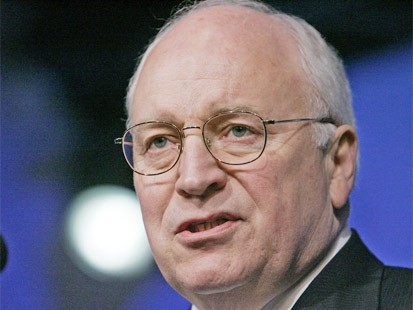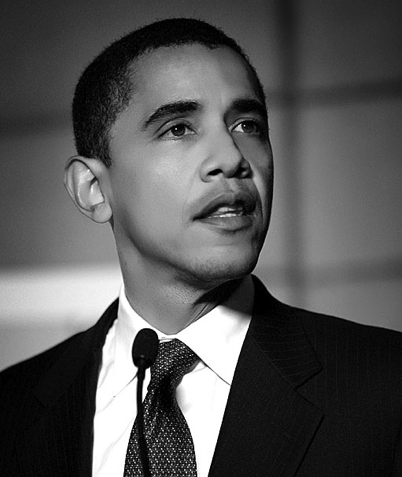



A month later, Tenet once again briefed the Bush administration. This time he presented information suggesting that Iraq did not have weapons of mass destruction, contrary to claims by the Bush administration. This argument was dismissed and never shared with Congress (Salon)
Than in September 2002, the Bush administration claimed to have evidence suggesting Iraq was making an effort to create nuclear bombs. This analysis was opposed by the US Department of Energy, who are considered experts in gas centrifuges and nuclear weapons programs.
An effort by the department to correct Colin Powell's forthecoming address to the United Nations on the issue was rebuffed. Powell later admitted he had presented inaccurate data to the UN, and that the intelligence he was relying on was in some cases "deliberately misleading." (Meet The Press)

This contrasts the small, innocent cowboy dressed version of George Bush we see looking curiously at the man on the ground. Right away Oliphant is using ethos and visual hierachy to demonstrate differences between Bush and Cheney. We see that Cheney is much larger in this photograph than Bush, showing superiority. We also see ethos in how Cheney is dressed in a suit, while Bush is dressed informal cowboy style with a look of almost childlike innocence on his face.
Because Cheney appears proffesional and business, he seems in control, though for the wrong reasons. Bush contrasts Cheney's ethos in that he does not come across professional or like he is the Commander in Chief. Cheney's towering size over the image also gives him dominance through visual hierachy. Oliphant is sending a message trough these nonverbal statements. He is saying that Cheney runs the show, and that Bush is merely a child in a man's world.
But Oliphant also makes it clear through pathos that we are not to trust Cheney. He looks intimidating, dark and shows no compassion. We don't feel like he is a man that should be trusted. Because this is a cartoon, this is his way of conveying a message that you will never read in a newspaper. Oliphant boldly argues that Dick Cheney is an evil person, and has no compassion for this soldier or any of the other things that he has done.

But even more important is the use of vector lines to draw our attention to the soldier laying on the ground. He is consumed in darkness and death, his pain the most real and emotional element we see in the image. He is a symbol of the sacrifice we make as a nation when we go to war.
Oliphant is using pathos to make us feel compassion for the soldier. Many Americans know someone who is serving in the military. Some even have close loved ones that are currently overseas in Iraq or Afghanistan. The emotional connection we feel to this soldier, and the possibility that he could represent one of our own friends or family being injured in the war, really drives this argument home. What if someone you cared about died under false pretenses? These thoughts enter our minds when we begin to connect with the image and it's nonverbal arguments.

We see more interesting use of body language when looking even closer at the physical relationship between Bush and Cheney. There is evidence to suggest Dick Cheney was the man responsible for what the war and what has resulted to this soldier. And while Bush is on his knees trying to comfort him, Cheney stares angrily from above into the man's eyes. Oliphant is saying that Bush, though uninformed and inept for the task at hand, feels bad about what has happened to the soldier. We see no such indications through body language or any form of communication from Dick Cheney.
But what really seals the message in this cartoon are the words spoken by Bush. "Would it make you feel better to know we had inaccurate intelligence?" This is reverse ethos, in that it boldly accuses Bush and his administration of making a costly mistake by not doing their job; and perhaps even lying to the country. And this soldier paid the ultimately price. Is his blood on Bush's hands? And was his sacrifice in vein? If you believe the administration lied to the country, than perhaps the answer is yes.

We may never know the answer to these questions. And last year, the backlash against the Republican party contributed to the first African American President being elected. Over time security in Iraq has improved dramatically. And perhaps in the end, some good came out of this war as things begin to settle down, and a new democracy is born in Iraq.
But we must never forget the lessons that we learned in 2003. A lesson clearly communicated in Oliphant's cartoon. With great power comes great responsibility. Oliphant is arguing that the United States must use discretion and work hard not to rush as a nation into important decisions with unknown repricussions. We must make sure the inteligence and the purpose are accurate and truthful. Because any war comes with great sacrifices.

As President Obama weighs his own wartime decision in whether or not to send troops to Afghanistan, let's hope he has learned lessons from his predecessor. For the actions and decisions of our last President ultimately cost this soldier and thousands more of their lives.
----
Works Cited
- “Casualties in Iraq” Antiwar. 2009. November 12th, 2009 <http://www.antiwar.com/casualties/>.
- “Cost of War” National Priorities Project. 2009. November 12th, 2009 <http://costofwar.com/>
- "The Dark Side" PBS Frontline. 2006. November 12th, 2009 <http://www.pbs.org/wgbh/pages/frontline/darkside/etc/script.html>
- "Bush Knew Saddam Had No Weapons Of Mass Destruction" Salon News. 2007. November 12th, 2009 <http://www.salon.com/opinion/blumenthal/2007/09/06/bush_wmd/>
- "Discussion on Iraq War." NBC's Meet The Press. 2004. November 12th, 2009 <http://www.msnbc.msn.com/id/4992558/>
No comments:
Post a Comment